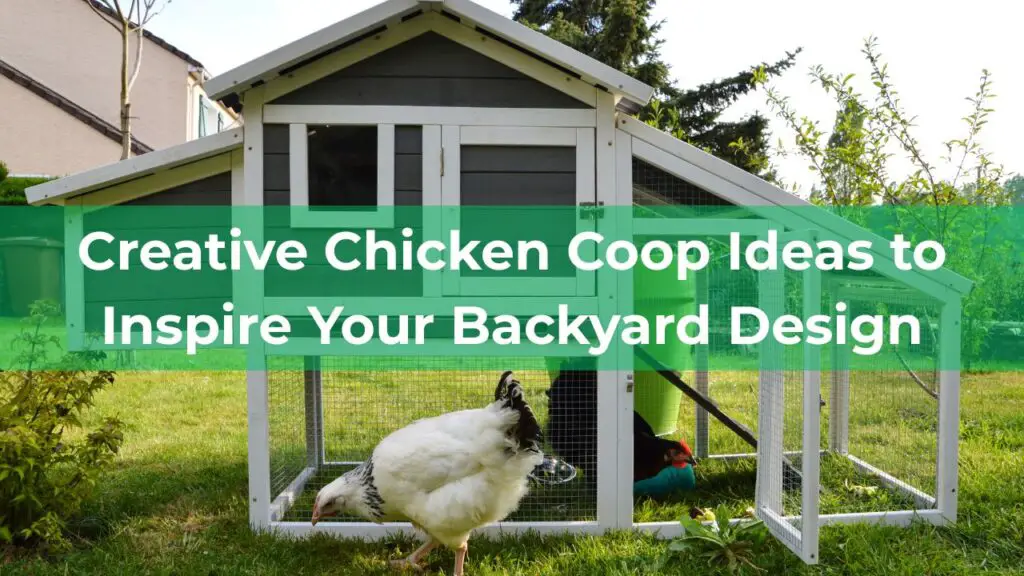Creating a vegetable garden is all about bringing fresh produce into your life while enjoying some time outdoors. Designing a garden that works for your space and lifestyle makes it easy to grow your favorite veggies. Let’s explore some fun ideas and practical tips to help you get started on your green thumb journey.
Seasonal Planting Calendar
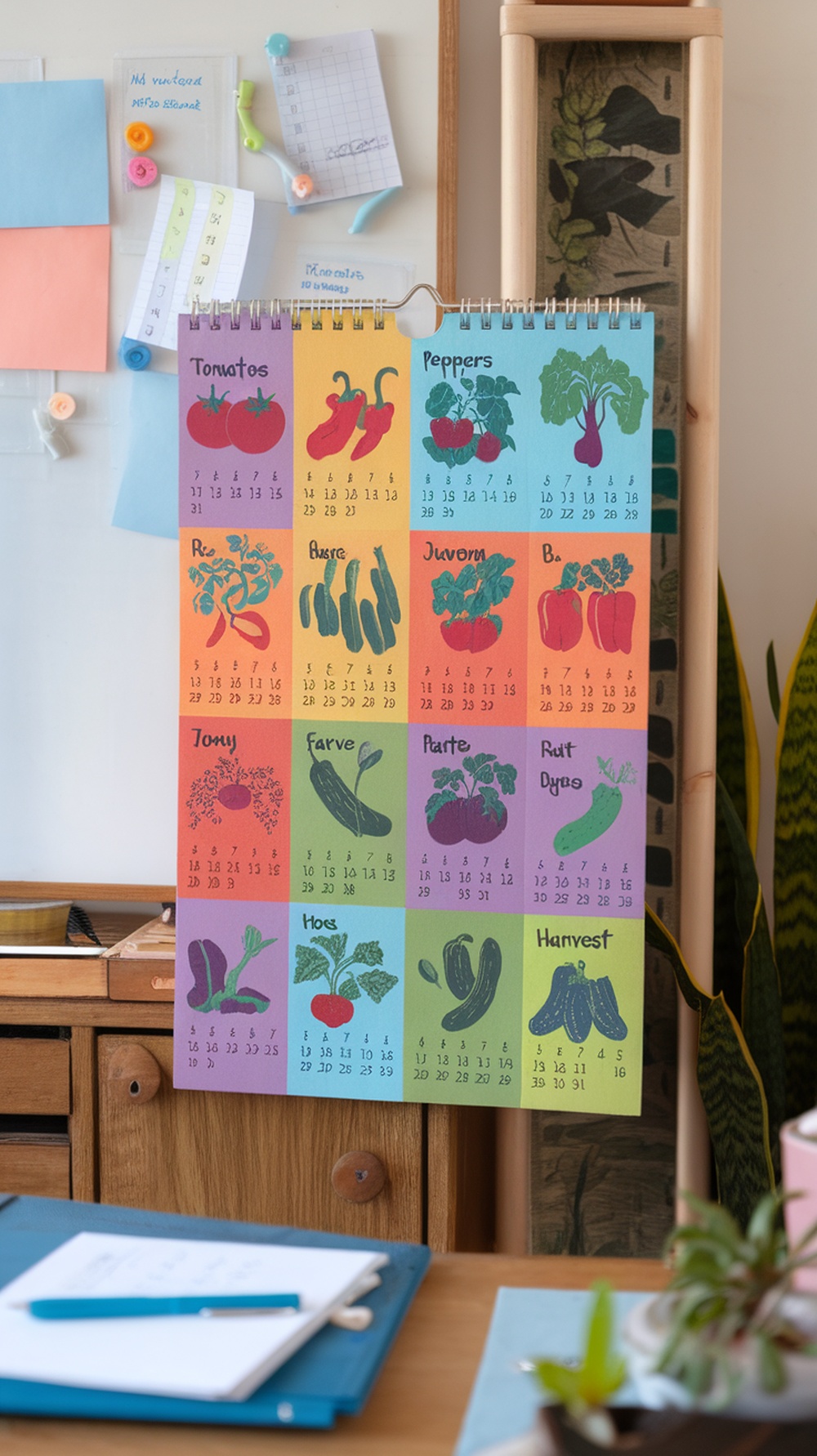
Planning a vegetable garden can be a fun and rewarding experience. A seasonal planting calendar is your best friend in this journey. It helps you know what to plant and when, ensuring that your garden thrives throughout the year.
The image shows a colorful calendar filled with various planting dates and tasks. It’s organized by months, making it easy to follow. Each section highlights specific vegetables and their optimal planting times. This way, you can maximize your harvest and enjoy fresh produce.
For example, early spring is perfect for planting peas and lettuce, while summer is ideal for tomatoes and peppers. Knowing these details can make all the difference in your gardening success.
Don’t forget to check the local climate and adjust your planting schedule accordingly. With a little planning, you can enjoy a bountiful garden all year long!
Choosing the Right Location
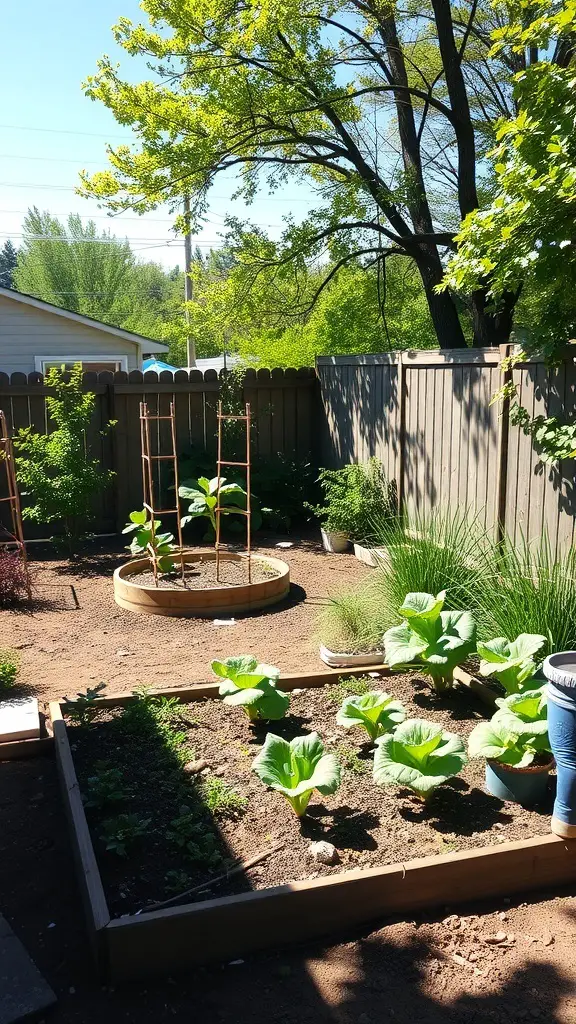
Picking the right spot for your vegetable garden can make all the difference. The image shows a lovely garden area with raised beds and a variety of plants. Notice how the sunlight filters through the trees, creating a bright and inviting space.
When choosing a location, think about sunlight. Most vegetables need at least six hours of direct sunlight each day. The garden in the image appears to have good exposure, which is great for growing healthy plants.
Next, consider accessibility. You want to make sure you can easily reach your garden for watering, weeding, and harvesting. The layout in the image allows for easy movement around the plants, making maintenance a breeze.
Lastly, think about drainage. The garden should not sit in a low spot where water collects. Good drainage helps prevent root rot and keeps your plants thriving. The raised beds in the image help with this, allowing excess water to flow away.
Watering Systems for Efficiency
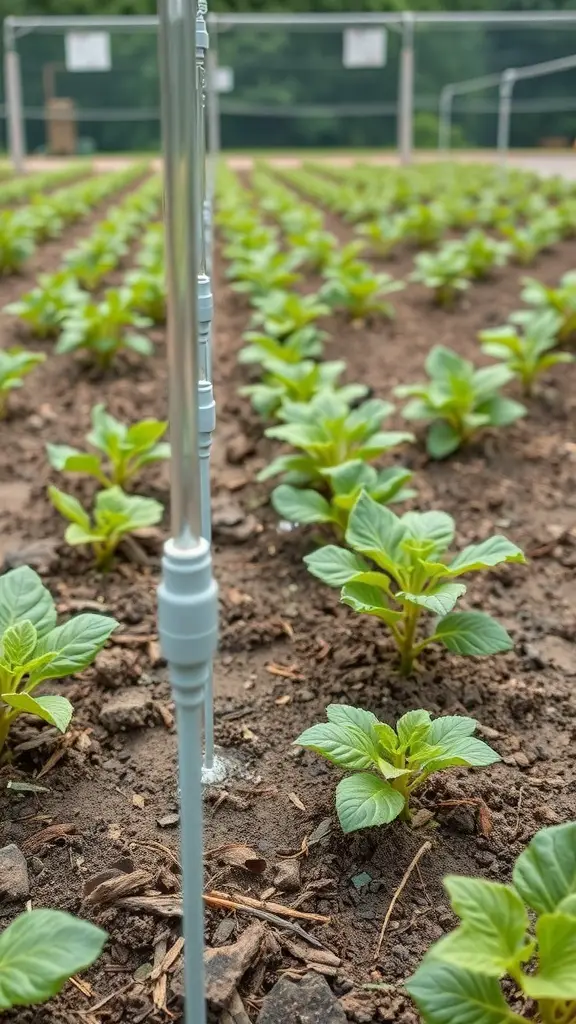
In a vegetable garden, having an efficient watering system is key to healthy plants. The image shows a well-organized setup with rows of young plants and a watering system in place. This kind of arrangement helps ensure that each plant receives the right amount of water without waste.
Drip irrigation is one of the best options for gardens like this. It delivers water directly to the roots, minimizing evaporation and runoff. You can see the tubes running alongside the plants, which means they are set up for targeted watering. This method is not only efficient but also saves time and effort.
Another great feature of this setup is the spacing between the plants. Proper spacing allows for better air circulation and sunlight exposure, which are essential for growth. With the right watering system, you can maintain healthy soil moisture levels, leading to a bountiful harvest.
Vertical Gardening Techniques
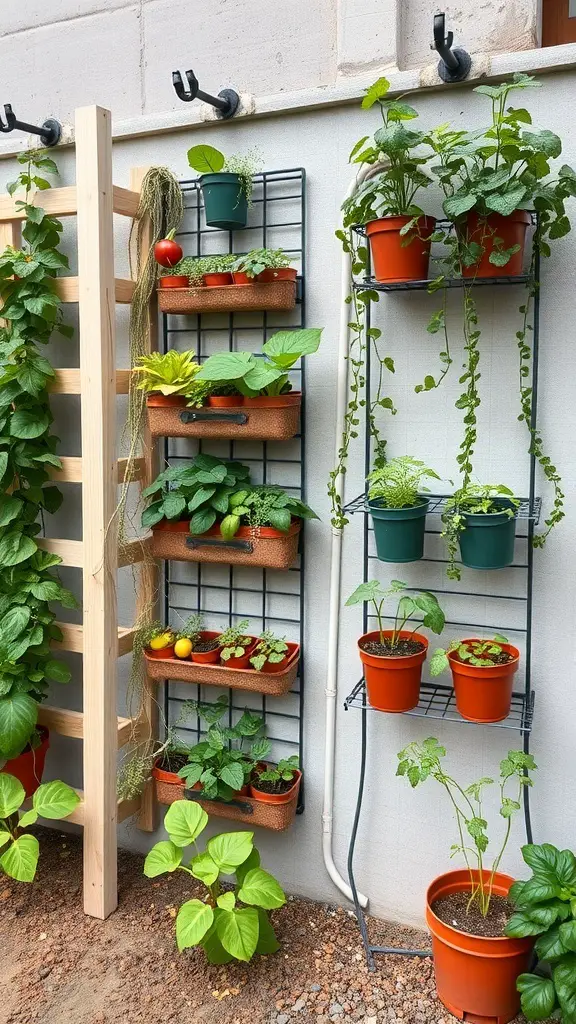
Vertical gardening is a fantastic way to maximize space, especially in smaller areas. The image shows a well-organized vertical garden setup, featuring various plants arranged on wall-mounted racks. This method not only saves ground space but also adds a visually appealing element to any garden.
On the left, there’s a wooden trellis supporting climbing plants, which can help create a lush green wall. The right side displays a metal rack filled with potted herbs and vegetables, showcasing a variety of colors and textures. This arrangement makes it easy to access and maintain the plants.
Using vertical gardening techniques allows you to grow more in less space. You can use wall-mounted planters, shelves, or even hanging pots. This approach is perfect for herbs, strawberries, and other small plants. Plus, it can enhance air circulation and sunlight exposure, promoting healthier growth.
Creating a Functional Layout
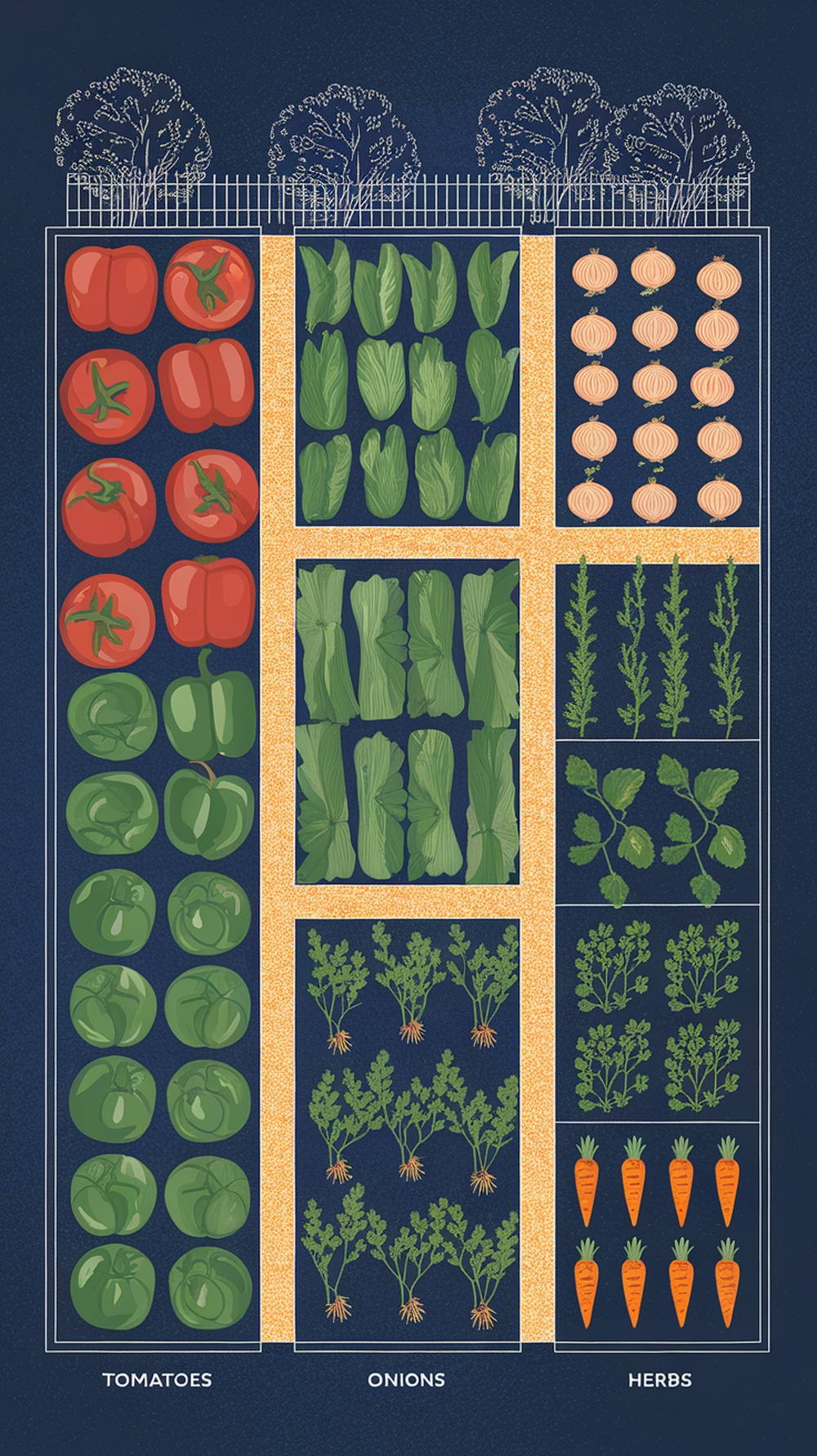
When designing a vegetable garden, layout is key. The image shows a well-organized garden space, divided into sections for various plants. Each area is clearly marked, making it easy to see what’s planted where. This kind of arrangement helps in planning and maintaining the garden.
The layout features a mix of leafy greens, tomatoes, and herbs, all thriving in their designated spots. This not only maximizes space but also makes it simpler to care for each type of plant. For instance, grouping similar plants together can help with watering and pest management.
Notice how the paths between the sections allow easy access. This is important for harvesting and tending to the plants without trampling on the soil. A functional layout like this can make gardening more enjoyable and efficient.
Incorporating raised beds or containers can also enhance the design. They provide better drainage and can be easier on the back. Whether you have a large yard or a small balcony, a thoughtful layout can transform your gardening experience.
Soil Preparation and Amendments
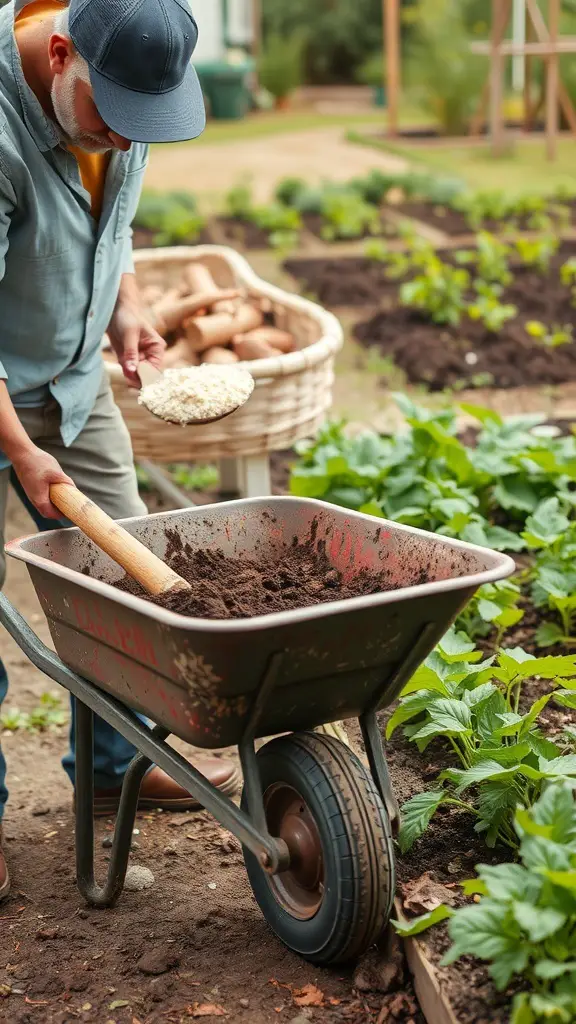
Preparing the soil is a key step in creating a thriving vegetable garden. The image shows a person mixing soil in a wheelbarrow, which is a common sight in gardens. This hands-on approach highlights the importance of getting your soil ready before planting.
Start by removing any weeds or debris from the garden bed. This clears the way for your vegetables to grow without competition. Next, consider testing your soil to understand its pH and nutrient levels. This can guide you in choosing the right amendments.
Adding organic matter, like compost, can significantly improve soil structure and fertility. The person in the image seems to be adding some kind of amendment, perhaps compost or a soil conditioner, which can help retain moisture and provide essential nutrients.
Don’t forget about drainage! Good drainage is crucial for healthy roots. If your soil tends to hold water, mixing in sand or perlite can help. Once your soil is prepared, you’ll be ready to plant your favorite vegetables and watch them flourish.
Companion Planting Strategies
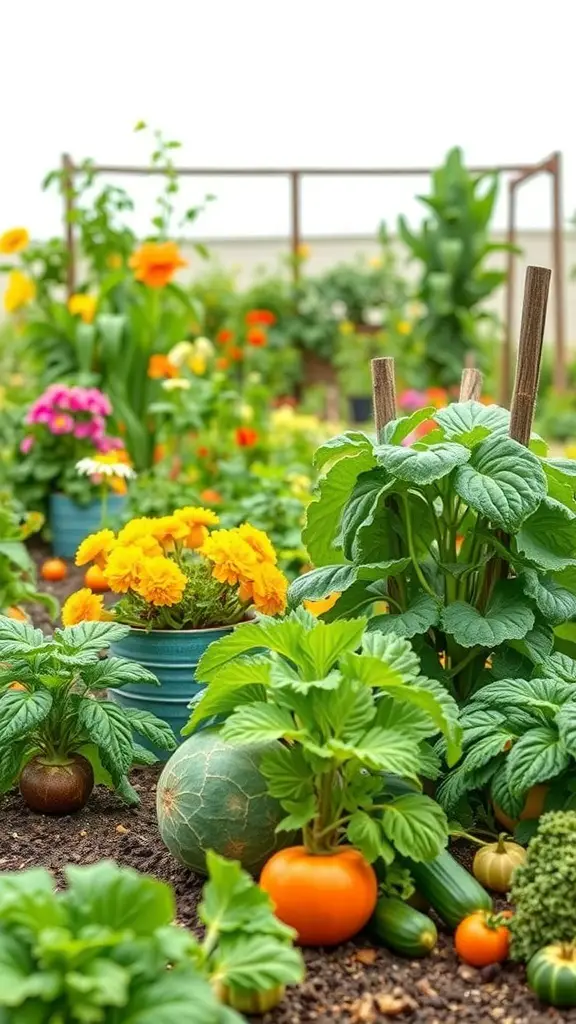
Companion planting is a fun and effective way to boost your vegetable garden. The image shows a vibrant garden filled with various plants, showcasing how different vegetables and flowers can thrive together.
In this garden, you can spot tomatoes, zucchinis, and melons, all growing alongside cheerful marigolds. Marigolds are known for their ability to deter pests, making them great companions for vegetables. This strategy not only helps protect your plants but also enhances the overall health of your garden.
Another great pairing is planting basil with tomatoes. Basil can improve the flavor of tomatoes and also repel harmful insects. Mixing flowers with vegetables, like in the image, adds beauty while promoting a healthy ecosystem. The colorful blooms attract beneficial insects, which can help with pollination.
When planning your garden, think about which plants can support each other. This not only maximizes space but also creates a thriving environment. Companion planting is a simple way to make your garden more productive and enjoyable.
Incorporating Raised Beds
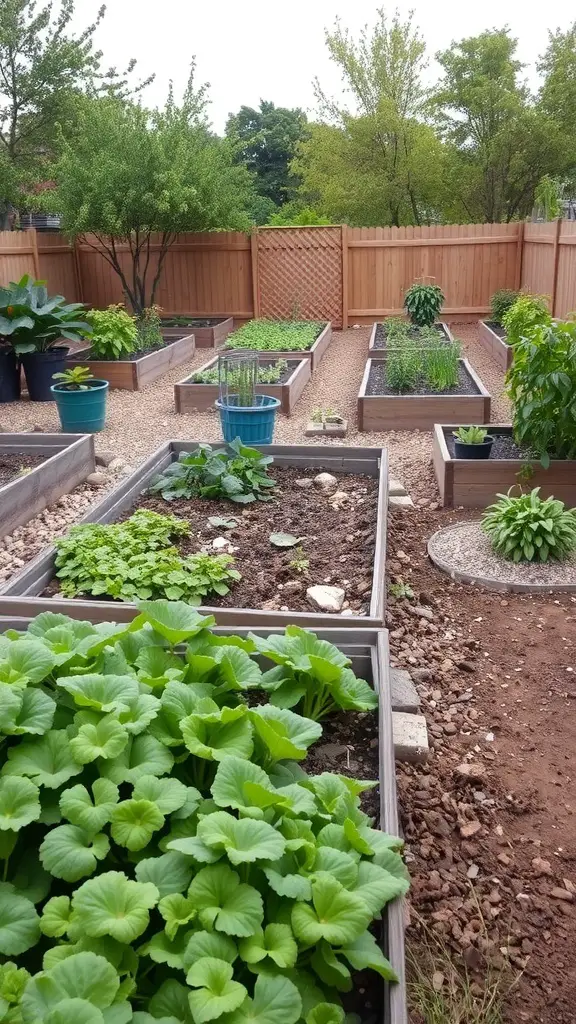
Raised beds are a fantastic way to grow vegetables, and the image shows a lovely example of this setup. The garden features several wooden raised beds filled with vibrant green plants, showcasing a variety of vegetables and herbs. This layout not only looks neat but also makes gardening more accessible.
One of the biggest advantages of raised beds is improved soil drainage. The soil in these beds warms up faster in spring, allowing for an earlier planting season. The plants in the image appear healthy and thriving, which is a testament to the benefits of this gardening method.
Another perk is that raised beds can help keep pests at bay. The height makes it harder for some critters to reach your plants. Plus, the defined space allows for better organization, making it easier to manage your garden.
In the image, you can also see a variety of containers, which add another layer of interest. These pots can be used for herbs or smaller plants, maximizing the use of space. This combination of raised beds and containers creates a productive and visually appealing garden.
Sustainable Practices in Gardening
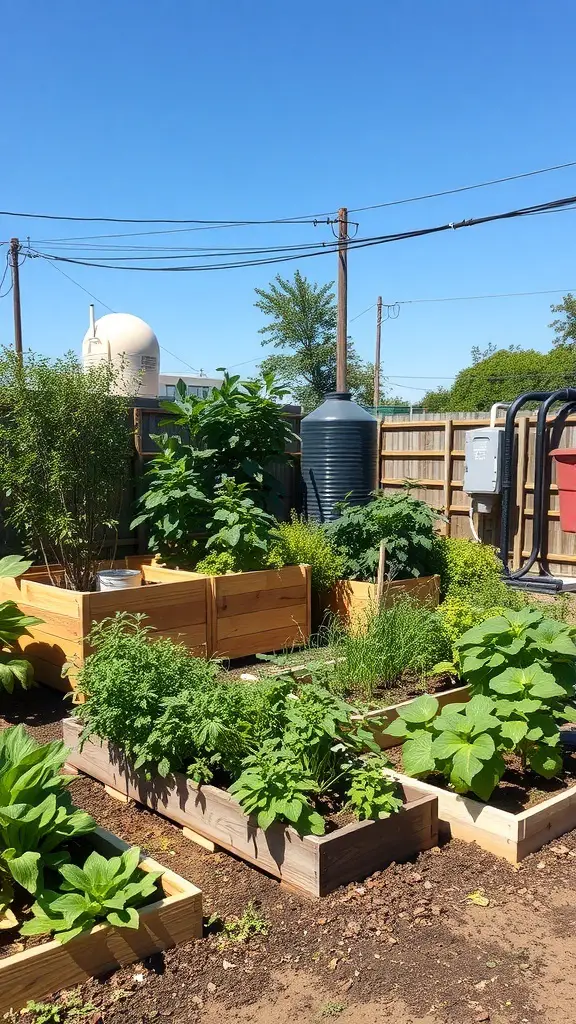
In this vibrant vegetable garden, you can see a variety of plants thriving in raised beds. These beds not only look neat but also promote healthy growth. Using raised beds is a great sustainable practice. They improve drainage and make it easier to control soil quality.
The garden features a rainwater collection system, which is an eco-friendly way to water plants. This method conserves water and reduces reliance on municipal sources. It’s a smart choice for anyone looking to garden sustainably.
Companion planting is another practice visible here. Different plants are grown together to enhance growth and deter pests. For example, herbs like basil can help protect tomatoes from harmful insects. This natural method reduces the need for chemical pesticides.
Overall, this garden is a perfect example of how sustainable practices can create a productive and beautiful space. By incorporating these techniques, anyone can enjoy the benefits of gardening while being kind to the environment.
Utilizing Garden Accessories
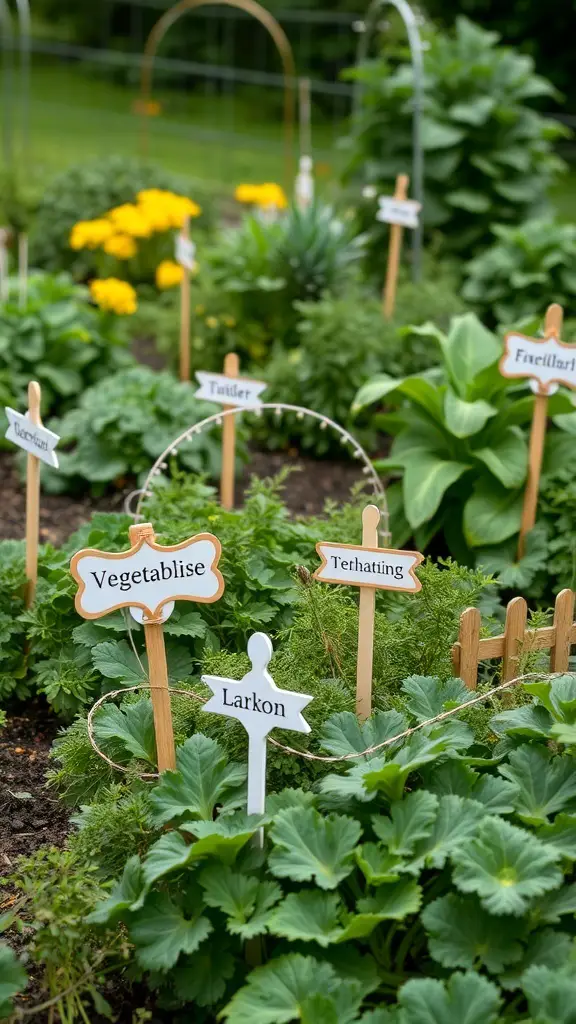
In a vibrant vegetable garden, accessories play a key role in both function and style. The image showcases a well-organized garden with labeled plants, making it easy to identify what’s growing. This not only adds a touch of charm but also helps in maintaining the garden.
Plant markers, like the ones seen here, are essential. They guide you in knowing which vegetables are planted where. This is especially helpful during the busy growing season when everything starts to look similar. You can easily keep track of your crops and their needs.
Another great accessory is the decorative fencing. It not only defines the garden space but also keeps out curious animals. The gentle curves of the fencing in the image add a playful element, enhancing the garden’s overall appeal.
Consider adding trellises or arches for climbing plants. They save space and create a beautiful vertical aspect. The combination of greenery and structure can transform your garden into a stunning visual experience.
Designing for Aesthetics and Functionality

Creating a vegetable garden is not just about growing food; it’s also about making a space that looks good and works well. The image shows a well-organized garden with neat rows of leafy greens, surrounded by lush greenery. This design balances beauty and practicality, making it a joy to work in.
The raised beds are a smart choice. They not only keep the soil well-drained but also make it easier to tend to the plants. The vibrant greens of the vegetables contrast nicely with the earthy tones of the soil, creating a pleasing visual effect. This layout encourages healthy growth while being easy on the eyes.
Incorporating flowers, like the bright yellow blooms seen in the background, adds color and attracts pollinators. This thoughtful combination enhances both the garden’s functionality and its charm. A garden like this invites you to spend time in it, whether you’re planting, harvesting, or just enjoying the view.
Harvesting Techniques for Maximum Yield
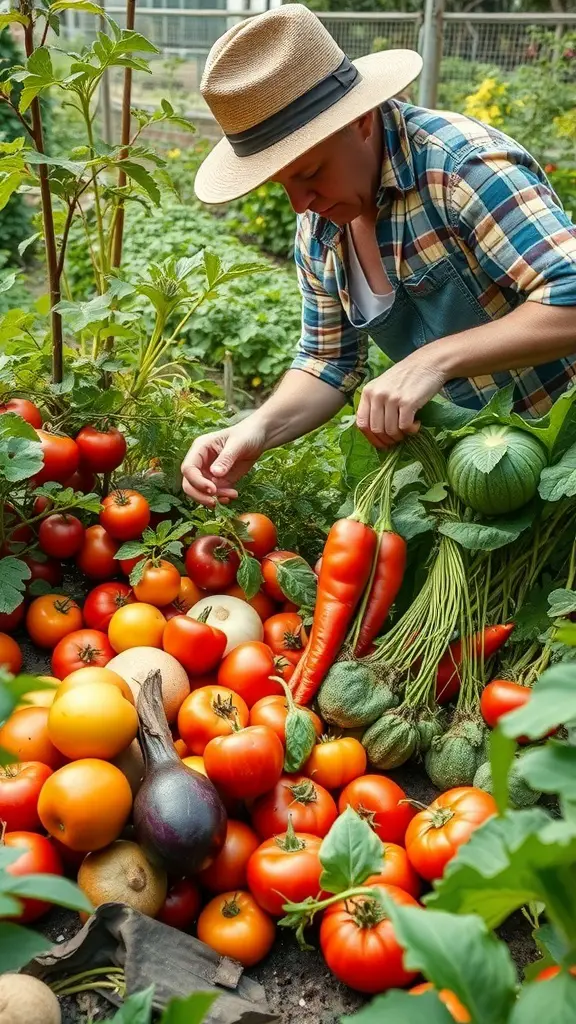
Harvesting is a key part of vegetable gardening. It’s not just about picking ripe veggies; it’s about timing and technique to get the most from your garden. In the image, we see a gardener carefully selecting ripe tomatoes and peppers, surrounded by a bountiful harvest.
To maximize yield, knowing when to harvest is crucial. Vegetables like tomatoes should be picked when they are fully colored and slightly soft to the touch. This ensures the best flavor and texture. Peppers can be harvested at various stages, depending on your preference for heat and sweetness.
Using the right tools can make a big difference. A sharp knife or scissors can help prevent damage to the plant, allowing it to continue producing. Always handle your vegetables gently to avoid bruising.
Another tip is to harvest in the morning when temperatures are cooler. This helps preserve freshness and flavor. Plus, it’s a great way to start your day in the garden!
Pest Management Strategies
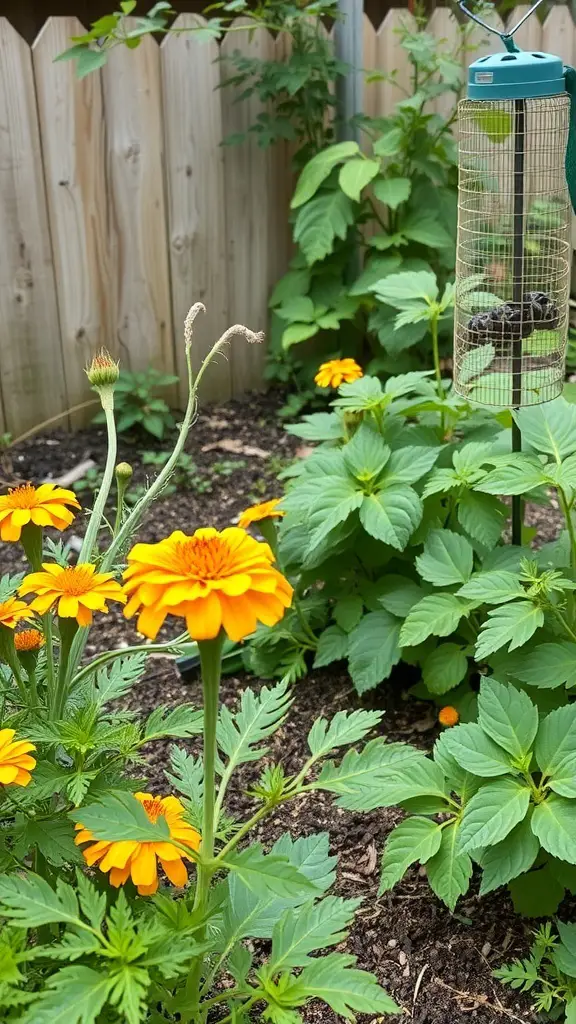
In a vibrant vegetable garden, pests can be a real challenge. The image shows a garden filled with bright marigolds and lush green plants. Marigolds are not just pretty; they play a key role in pest management. Their strong scent can deter harmful insects, making them a great companion plant.
Another strategy is to introduce beneficial insects. Ladybugs and lacewings are natural predators of aphids and other pests. By creating a welcoming environment for these helpful bugs, you can keep your garden healthy without harsh chemicals.
Physical barriers, like row covers or nets, can also protect your plants from pests. These barriers allow sunlight and rain to reach your veggies while keeping unwanted critters out. Regularly inspecting your plants for signs of trouble is important too. Catching issues early can save your garden from bigger problems down the line.
Lastly, maintaining healthy soil is crucial. Healthy plants are more resilient to pests. Composting and rotating crops can improve soil health, making your garden a thriving ecosystem.

